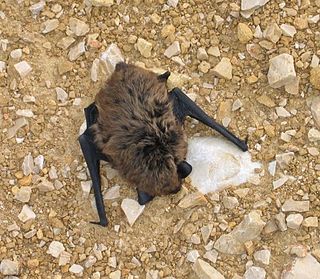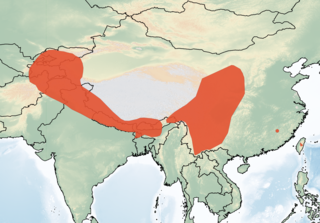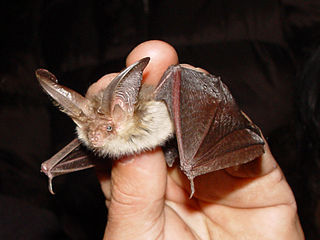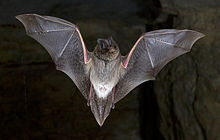
Natterer's bat is a European vespertilionid bat with pale wings. It has brown fur tending to greyish-white on its underside. It is found across most of the continent of Europe, parts of the Near East and North Africa. It feeds on insects and other invertebrates which it catches on the wing or pursues on the ground.

The serotine bat, also known as the common serotine bat, big brown bat, or silky bat, is a fairly large Eurasian bat with quite large ears. It has a wingspan of around 37 cm (15 in) and often hunts in woodland. It sometimes roosts in buildings, hanging upside down, in small groups or individually. The name serotine is derived from the Latin serotinus, which means 'evening', while the generic name derives from Greek ἔπιεν and οίκος, which means 'house flyer'.

The lesser horseshoe bat is a type of small European and North African insectivorous bat, related to its larger cousin, the greater horseshoe bat. As with all horseshoe bats, the species gets its name from its distinctive horseshoe-shaped noseleaf.

The greater noctule bat is a rare carnivorous bat found in Europe, West Asia, and North Africa. It is the largest and least studied bat in Europe with a wingspan of up to 46 centimetres (18 in) and is one of the few bat species to feed on passerine birds. Greater noctule bats are the only bat species to hunt birds on the wing rather than when roosting. The greater noctule bat has wings adapted for open-air hunting and uses echolocation frequencies above the hearing range of birds.

The soprano pipistrelle is a small species of bat. It is found in Europe and often roosts on buildings.

The lesser noctule, Leisler's bat or the Irish bat, is a species of insectivorous bat belonging to the vesper bat family, Vespertilionidae. The species was named to honour the naturalist Johann Philipp Achilles Leisler.

Savi's pipistrelle is a species of vesper bat found across North West Africa, the Mediterranean region and the Middle East. It feeds at night on flying insects. In the summer it roosts under bark, in holes in trees, in old buildings and in rock crevices but in winter it prefers roosts where the temperature is more even such as caves, underground vaults and deep rock cracks.

The common noctule is a species of insectivorous bat common throughout Europe, Asia, and North Africa.

The Hawaiian hoary bat, also known as ʻōpeʻapeʻa, is a species of bat endemic to the islands of Hawaiʻi. The Hawaiian hoary bat occupies the major Hawaiian islands, making it the only extant and native terrestrial mammal in the islands. Some studies report that the mainland hoary bat lives in sympatry on the Hawaiian Islands alongside the Hawaiian hoary bat, although this is disputed. The Hawaiian hoary bat was officially named the state land mammal of Hawaiʻi in 2015. It is a federally listed endangered taxon of the United States.

The Arabian barbastelle, also known as the levant barbastelle, is a species of vesper bat. Its habitat is temperate forests and caves. It is threatened by habitat loss. It is found in Egypt (Sinai), Israel, and Eritrea.

Nyctophilus geoffroyi is a vespertilionid bat. a flying nocturnal mammal found in Australia, The species is relatively common. They have been referred to as the lesser long-eared bat.

The south-eastern long-eared bat or Corben's long-eared bat, is a species of bat found in Australia. It occurs in the woodlands of the Murray Darling Basin and adjacent areas.

Bechstein's bat is a species of vesper bat found in Europe and western Asia, living in extensive areas of woodland.

The Mauritian tomb bat is a species of sac-winged bat in the family Emballonuridae that is found in central and southern Africa and Madagascar. It was discovered in 1818 by Étienne Geoffroy Saint-Hilaire, and is characterized by an all-white ventral surface, grizzled dorsal coloration, and conical face. It has exceptionally good eyesight, a trait which is common in old world bats and enables it to find roosting locations. It has adapted itself to a wide range of habitats including subarid scrub to semi-tropical savanna and can be found throughout much of Africa south of the Sahara, including many of the surrounding islands. They often seek out refuge in cool dry areas. Mauritian tomb bats help control pest populations, including insects that carry human diseases. These bats tend to be nocturnal hunters and their normal prey consists of moths, butterflies, and termites. Not prone to large-scale roosting, T. mauritianus is most often spotted on the sides of buildings or on the trunks of trees in groups of around five individuals. They breed on average once or twice a year and rear usually one pup, though twins are occasionally reported. They usually deposit their hungry offspring in areas where they can feed voraciously, most often in berry bushes. This species is listed as least concern on the IUCN Red List due their wide distribution and stable population.

The Agreement on the Conservation of Populations of European Bats, or EUROBATS, is an international treaty that binds its States Parties on the conservation of bats in their territories. It was signed in 1991 under the auspices of the Convention on the Conservation of Migratory Species of Wild Animals (CMS), with the Agreement entering into force in 1994. In August 2021, the Agreement applied to 38 of 63 range states.

The Alcathoe bat is a European bat in the genus Myotis. Known only from Greece and Hungary when it was first described in 2001, its known distribution has since expanded as far as Portugal, England, Sweden, and Russia. It is similar to the whiskered bat and other species and is difficult to distinguish from them. However, its brown fur is distinctive and it is clearly different in characters of its karyotype and DNA sequences. It is most closely related to Myotis hyrcanicus from Iran, but otherwise has no close relatives.

The Devon Bat Group (DBG) was founded in 1984 to help protect bats and their habitats, to look after injured bats and to advise and educate people about bats.

The Mediterranean long-eared bat, also known as Kolombatovic's long-eared bat, is a species of vesper bat ranging from Italy east through the Balkans east to Syria, and south to Jordan.

The eastern barbastelle or Asian barbastelle is a species of vesper bat found throughout much of Asia, from Afghanistan to Taiwan.

Plecotini is a tribe of bats in the family Vespertilionidae. It contains several genera found throughout the Northern Hemisphere, in Eurasia, North Africa, and North America. Several genera in this tribe are known as big-eared bats or long-eared bats. It also contains the spotted bat and barbastelles.























